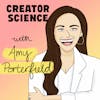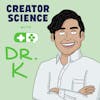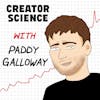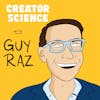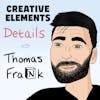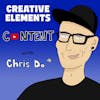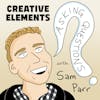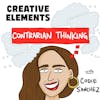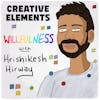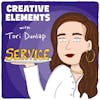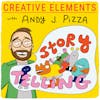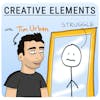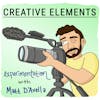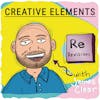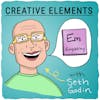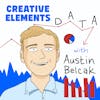
#113: Austin Belcak – From zero job offers to attracting 1.3 million followers on LinkedIn
Play EpisodeAustin Belcak is the founder of Cultivated Culture, which people how to land jobs they love without “traditional” experience and without applying online.
WATCH
▶️ Watch this episode on YouTube
***
EPISODE DESCRIPTION
Austin Belcak is the founder of Cultivated Culture, which people how to land jobs they love without “traditional” experience and without applying online.
Austin has 1.3 million followers on LinkedIn and his posts have been viewed hundreds of millions of times. He's recently started investing time into Twitter, where he already has more than 50,000 subscribers.
In this episode, we talk about Austin’s approach to content creation, what content is working on LinkedIn today, why good people give bad advice, and how being Data Driven helped him become one of the biggest accounts on LinkedIn.
Full transcript and show notes
Learn more about Austin Belcak
Follow Austin Belcak on LinkedIn / Twitter
TIMESTAMPS
00:13 - LinkedIn is underrated
00:40 - Today’s guest
01:07 - The problem with our education system
02:03 - Applying to tech companies
03:34 - Is Austin LinkedIn’s TOP creator?
04:20 - What we learn today
04:58 - What do you want to be when you grow up?
05:42 - Austin’s early interest in entrepreneurship
06:29 - Good people give bad advice
08:45 - Learning the RIGHT way to get hired
11:09 - People project their own shortcomings onto you
14:32 - Sometimes your friends work against you
15:40 - Seeking approval from others is a bad idea
18:03 - You have to fail a lot
19:12 - Austin’s first piece of content
20:58 - Starting to create on LinkedIn
22:24 - Early struggles creating content
24:56 - Ways to remove anxiety from creating
25:35 - Developing habits
27:10 - Austin’s content posting cadence
32:09 - Importance of luck
32:59 - Importance of data
33:39 - Find a medium that gives you energy
34:21 - Analyzing your content to improve
37:13 - Why analyzing content is important
39:08 - New LinkedIn carousel strategy
41:24 - Longevity of LinkedIn content
43:00 - Austin on building genuine relationships
47:40 - Using a CRM to track relationships?
***
CONNECT
🙏 Make a guest or mailbag request
📝 Check out our curated Playlists
***
SPONSORS
💼 View all sponsors and offers
***
SAY THANKS
💜 Leave a review on Apple Podcasts
***
PODGLOMERATE NETWORK
This show is a part of the Podglomerate network, a company that produces, distributes, and monetizes podcasts. We encourage you to visit the website and sign up for our newsletter for more information about our shows, launches, and events. For more information on how The Podglomerate treats data, please see our Privacy Policy.
Since you're listening to Creative Elements, we'd like to suggest you also try other Podglomerate shows surrounding entrepreneurship, business, and careers like Rocketship.fm and Freelance to Founder.
Learn more about your ad choices. Visit megaphone.fm/adchoices
Austin Belcak 00:00
I was scared man like I was worried about what my employer would say I was worried about what my friends would say I would worry. I was worried about what, what people on the internet would say. I had all this fear.
Jay Clouse 00:12
Hello, my friend. Welcome back to another episode of creative elements. I've been spending a lot more time on LinkedIn lately. I think a lot of people are sleeping on LinkedIn as a platform for creators. Just about two years ago, I started a newsletter on LinkedIn as part of their Beta program. And the growth was insane. I was picking up hundreds of subscribers per week, like 500 subscribers per week. And today, that newsletter has more than 34,000 subscribers. But that success pales in comparison to today's guest, Austin Belcak. Austin has 1.3 million followers on LinkedIn, and more than hundreds of millions of views of his content. Part of the reason that Austin is so successful is just how well his content fits the platform. This company cultivated culture helps people find jobs without applying online and his story starts in college, when like many of us, he was trying to figure out what he wanted to be when he grew up.
Austin Belcak 01:08
I really had no idea what I wanted to do. And I think that's, that's one of the disk services that our education system does to us is sort of forcing us to choose very early on and not giving us a ton of options. So with this persistent question, kind of weighing on me, but no real options for exploration. I just kind of went to what was familiar these, like TV careers, is what my friend Madeleine man calls and she's another awesome follow on on LinkedIn and other platforms, basically, you know, those careers that you see on TV doctor, lawyer, accountant, you know, so on and so forth. So I chose doctor, and that made my parents happy that made teachers happy and made everybody else happy, didn't really make me happy. So I get to college, I failed a couple classes early on, my GPA is not in a place where med schools are going to be taking a chance on me. And I basically coast through the rest of college because I'm pretty disheartened. And I don't know where to go. So when I graduate, I end up with this job that is totally not aligned with anything that I want doesn't pay me enough. It's not really an industry that I was really psyched about it was in healthcare. My boss was a jerk. And I realized that I needed to make this transition.
Jay Clouse 02:14
That lack of alignment turned into frustration. And Austin began looking for jobs that had better alignment. Specifically, he knew that he wanted to be an entrepreneur one day. So we started to look at applying to tech companies. But unfortunately, that was not as easy as he thought it might be.
Austin Belcak 02:29
You know, think Google, think Microsoft, Meta, so on and so forth. All of these companies that are heavily involved, and whose products are basically the core of the digital marketing ecosystem, let me work there, let me learn, let me get paid. Well, let me surround myself with amazing people. And then let me go figure out that entrepreneurial thing I had 300 apps in, I had five interviews, none of which came from those applications. They all came from kind of the family friend or networking or any of that, like people I already knew. But most importantly, I got zero offers. And the definition of insanity, right is doing the same thing over and over again and expecting a different result. And at this point, I truly felt like I was I was going insane, which your reaction kind of kind of testifies to.
Jay Clouse 03:10
So Austin found another way in, you had a really important conversation that we'll talk about in the interview that helped him to realize he was taking the wrong advice from the wrong people. He created an entirely new process and approach for himself that helped him land interviews at Uber, Twitter, Google and Microsoft, where he eventually spent more than five years working people began to ask him how he landed this job at Microsoft. And so we started writing on LinkedIn. And that is when things really took off. Are you the most followed person on LinkedIn?
Austin Belcak 03:38
I don't think so. There are definitely some other folks who have a couple million more but they're like celebrity people. Like yeah, exactly. It's it's I remember, I was helping a friend of mine with their with their profile, and we were on LinkedIn. And there was like a suggested people to follow. And it was like, Bill Gates, Satya Nadella. And then like, my face was there, and I was like, This is insanity. And it's surreal. Like I I'm like a regular dude, like, I'm not a I'm not. I don't think of myself any differently than I did when I started on LinkedIn. And to see stuff like that still just like blows my mind. And it's totally surreal. And it also never ever gets old. But I have to pinch myself still, when I see that number. It's insane.
Jay Clouse 04:18
So in this episode, we talked about Austin's approach to content creation. What is working today on LinkedIn? Why good people give bad advice, and why being data driven has helped them become one of the biggest profiles on the platform. I'd love to hear your thoughts on this episode. As you listen, you can tweet at me or find me on Instagram @jayclouse, tag me, let me know that you're listening or just leave a comment below on YouTube. Alright, let's dive in. Let's talk with Austin.
Austin Belcak 04:58
You know when you're able to walk and talk, you're like a little tight. You go to school, you know, your teachers, your parents, everybody asks you well, what do you want to be when you grow up? And it's like, you can say anything you want astronaut, NFL quarterback, you know this, that or the other thing and everybody cheers you on. But then something weird happens like you grow up, the question persists, but the scope of acceptable answers kind of narrows a little bit, right. And now all of a sudden, being a writer is not quote, realistic, right? You can't really make any money doing that, and being you know, any of these things that we might be passionate about all of a sudden, our parents, our teachers, they sort of say, well, that's nice, that's fun, maybe as a hobby. But why don't you get more realistic? Why don't you go pick a career or major or whatever it is, that will actually lead to job opportunities. One thing that I did have a lot of clarity on from a fairly early age was that I did want to be an entrepreneur, I saw that entrepreneurs had a lot of control over their outcomes, and didn't necessarily have to play by all of the traditional rules in order to see success. And that really aligned with the way that I thought that I operated. And when I saw all the entrepreneurs who had the businesses that I want to emulate, which were mostly, you know, these online entities, I thought, Okay, well, I need to get, I need to get my skills up, I need to get in the game with this digital space, I need to learn SEO, content, marketing, you know, social media, I need to figure all this stuff out. I also knew that I didn't have the business savvy or experience to really get out there and start my own thing just yet. So I thought, why don't I go work for one of these companies that will help me build those skills, but also allow me to live the life that I want to live. The problem was, I only knew of one system. And that was the system that basically everybody talks about everybody teaches us, which is this traditional path of tweaking your resume writing a cover letter, showing up on job boards every day. And applying online, I did that at first because when I wanted to make the career change, I went to all the folks that I've typically gone to for advice, and I think all of us go to for advice, right? We talk to our parents, we talk to our friends, we talk to whatever resources are available to us. In my case, it was you know, the Alumni Services and Career Services at my alma mater. And they all told me the same thing, which was to go buy into that system. And so that's what I did for the first month, I started tweaking my resume Shut up on LinkedIn, you know, I applied for these jobs. I applied for about 100 jobs in the first month. And I got absolutely nothing out of that. And I went back to all these same people. And I said, Well, what's the deal here? You know, I'm doing what you have told me to do. You're the people that I've, you know, trusted and come to you for advice forever? Can you shed some light on what I'm doing wrong? Can you give me guidance. And this was kind of the first major red flag where everybody kind of told me, Well, it's a numbers game. And you just need to keep getting out there and apply for more jobs. And that was confusing to me, because I thought, well, now I've already applied to all the jobs that I actually really want, that I'm excited about. So if you're telling me I need to go back out there and apply for more jobs, these jobs aren't going to be the ones that aligned with the criteria that I'm looking for. And so that doesn't feel great. But I do want to get the heck out of my situation. So okay, let me go about this. And let me double down. Because if I'm really going to commit to this, and you're saying, this is the path, I need to give it a fair shot. So I basically made a commitment to myself to apply to 200 jobs over the next month. And around that same time, I had a conversation with somebody else who went to Wake Forest where I went to school, he was working at Uber, and he essentially told me, you know, Austin, look, you're doing a lot of the right stuff, but you're taking advice from the wrong people. So your parents, these career counselors, they may have your best interests in mind, but they haven't walked the path that you're looking to walk, you know, they haven't gone from somebody who had a biology degree and terrible grades and a job in healthcare to working at Google or whatever it is. So what you need to do is go out and find those people. So I left that conversation feeling energized, I went home, I made a list of the criteria for my dream job, which was, you know, working at one of those Fang type companies living in a major city, New York, LA, et cetera, making six figures a year, being able to work from anywhere, and then finally, D being able to do all that before the age of 2526. So I took that list, and I went to LinkedIn. And this was kind of when I actually first started diving deeper into LinkedIn and viewing it as more than just a digital resume. But I used the platform to go out and find people who had landed a job at one of those companies who met all the criteria on my list, but who also came from a non traditional background. So I reached out to as many of those people as I could, I learned a ton from them. And I looked for common threads. And I looked for strategies that I felt that you know, played to my strengths and that I could leverage. And basically what I realized was if I wanted to land a job, if I wanted to make this happen, there were two core things that I needed to basically, like, bring into my job search or build my job search around. The first was getting a referral, like literally every single person that I spoke to had gotten a referral at one of these companies. None of them had gotten the door via cold online application. So that was the first piece. The second piece was that almost all of them had found some sort of creative way to illustrate their value. That went beyond the bounds of a resume or a cover letter. So some people were creating content, some people had a portfolio site, some people had these side projects or side hustles. And so I had to go figure out my own way to do that. So those were the two kind of core principles that I said I was going to build my job search system around, and then I kind of made it my mission to get out there and just tear apart this whole process and figure out how it worked. So long story short, over the next about a year and a half, I did a lot of trial and error, I made a ton of mistakes, I failed a ton. But I eventually kind of refined this system to a place where I could effectively pick and choose the companies that I wanted to land interviews at. And that led to interviews like Google, Microsoft and Twitter, and then eventually, the offer at Microsoft that I accepted on their partnerships team. So at a high level that that's, that's kind of my journey there. But those same concepts that I learned in principles and strategies, especially around networking, and especially around finding innovative ways to showcase your value. Those are also core principles that I brought with me to my entrepreneurial journey and my journey as a creator. And I don't think that I would have been as successful as a creator and an entrepreneur had I not gone through that process.
Jay Clouse 11:09
Man, something I really want to double click on real quick. This advice you got from your friend saying, you're taking advice from the wrong people, talk to people who already have what you're trying to get that is so important. And when you hear that for the first time, you're like lightbulb, duh. But we spend so much of our lives just thinking that our parents, all these adults and authority figures around us they have answers to any question, right. But man, I wish I could download that knowledge and give it to everybody, because so many people follow well meaning advice, that is not helpful, because it's basically just people who are trying to justify the choices and the path they've taken not necessarily conceptualizing to you, or for the outcome you're actually trying to get. So I really just wanted to underscore that for a second, it's so important.
Austin Belcak 11:59
Definitely, it's so important to realize that the person who's sharing this advice, in some cases, they're trying to protect you, right parents, friends, they don't want to see you struggle. And so a lot of times the things that we want most in life require taking a bit of risk and probably require a bit of struggle, and our family, our friends, they just, they don't typically want to see that for us, they wanted to kind of fast forward through that and get to the outcome. But there's no way for us to do that. So it's important to understand that it's also important to understand that there are people who see your dreams and goals and realize that they can't have those things for themselves. And they push their limiting beliefs, or they push that jealousy on to you. And just one example of this was in my junior year, I was taking an English course. And when midterms rolled around my transcript said that I had a D in English. So I went to the English teacher, and I said, you know, what can I do here? What's wrong? How can I improve, and he basically told me, you know, effectively, don't get a job as a writer, because you are going to fail at it. And you'll never have this career and writing and I didn't want to be a writer, I wasn't an English major, I actually didn't love writing. But this guy was basically telling me, you know, you better find a day job somewhere else, because you're kind of a lost cause. And now, you know, fast forward to where we are today, you know, my content has has seen, you know, hundreds of millions of views, you know, I have a million plus followers on LinkedIn, all these other things that have stemmed from my writing. And so if I had just listened to that person, and taken what he had said, as as the truth, I would have never gone down this path. But instead, I tried to look at where he was, and and what he might have gone through. And maybe he had certain aspirations of becoming a writer himself, seeing some of these things come to fruition, maybe those didn't happen. And he still landed a great job as a professor of, of, of English, but there might have been a little bit of you know, I couldn't do this. And so you might not be able to, to especially given the fact that you know, your writing as as, as far as I see, it kind of sucks. And so I had to come to that realization, I had to accept that what this person was telling me wasn't necessarily my truth. And then I frankly, just use it as fuel to say, Alright, you're telling me I can't do this, I believe that I can. So every single time I don't want to write every single time I'm frustrated every single time I'm thinking about giving up, I'm gonna go back to that conversation. And that's the fuel that that I'm going to use to sit down and crank out that post or do whatever I need to do today to keep the streak going.
Jay Clouse 14:30
I hope people are really taking this to heart too, because this is one of the most difficult parts that I've dealt with as a creator, that I think a lot of creators hit this point, especially when you find consistency. And you continue to deliver over time when you initially say hey, I'm going to do this thing. A lot of your friends and family, they show up for you and they're excited for you at least outwardly. But as a little bit of time passes and if you are consistent and you're actually making progress, you start to notice that those same people that you were happy that they were happy For you stop being as outwardly supportive often, and I don't think it's a conscious malicious thing, but I do think it is that kind of deep seated reckoning with their own identity of this person is pursuing the things that they want to do. And it makes me feel bad because I'm not doing that. And in some ways, I've seen friends, people close to me actively, like work against me in small subtle, whether conscious or subconscious ways. And it's hard, it hurts, it's hard to deal with. So thrown that out to folks listening to those who are either experiencing that now or may come to experience that I think it's actually very common to experience that.
Austin Belcak 15:43
100% and it's so important to know that if you're seeking approval from others, your and that's the basis of your, you know, your getting started, you're never going to start and stick with it for as long as you need to, to see the results that you want, like the permission has to be your own. And you have to just get out there and not worry about other people's approval, because by the time you get that approval, which you know, I'm sure at this point, Jay, you know, those same people might come back and say your podcast is killing it. You know, I love what you're doing on Twitter, blah, blah, blah. And you're like, Yeah, but you know, Where where are you for the last, you know, however, however long when I really needed that support, I don't need it. Now I have this audience, I have this community, I have this amazing podcast, like I don't need your approval anymore. And that's, that's what I see time. And again, by the time we get to the point where other people finally give us their approval, we don't need it. And so if you're waiting for that, you're gonna be waiting a long time, and you're probably never gonna get started.
Jay Clouse 16:38
After a quick break, we talked about how Austin became one of the biggest creators on the platform. And later, we talked about what type of content is working well on LinkedIn right now. So stick around and we'll be right back.
Jay Clouse 16:50
Welcome back to my conversation with Austin Belcak. With 1.3 million followers on LinkedIn, Austin is easily one of the biggest accounts on the platform. So I asked him to walk us through how he got here.
Austin Belcak 17:00
Yeah, so it goes back to that that overarching goal of wanting to be an entrepreneur, and I was always looking for ideas. So in college, I started a music blog, my junior year. And I think like, I think that the site got like 250 visits total, like in its multi year lifespan before I got too busy and shut it down. But that taught me how to build a website. I built it on WordPress, I did it all myself. Then a couple of years later, I wanted to do this apparel company, which like, you know, we've all had the idea for the apparel company at some point. And obviously, that didn't work out. But I worked with vendors and designers and freelancers. And so I got that knowledge. And then after I graduated, I wanted to build an app. And I started, you know, hired a developer, we started wireframing, we did all this stuff. And then three venture backed companies all came out with the same app in this in the span of 30 days. And I was like, Well, you know, I'm screwed. So I dropped that project. But I learned a ton about, like how to build an app and do all of this, this stuff that you basically need to learn in order to basically be competitive in today's world on the internet. So I had all these failed projects. And I say all that to say that one, you have to fail a lot before you find something that clicks. But that leads to the idea that eventually did work, which is once I got this job at Microsoft, a lot of people kind of came out of the woodwork and they were like Austin, especially they were mostly people from college. And they were like Austin, like you never studied, you had horrible grades you worked in health care, like, what is this? How did this happen? And first off, I laughed with them. I'm like, I don't know, this is still like crazy to me. But I walked them through that hole basically what I told you like, look, I was going through this traditional process, it wasn't working. And so I had to find this other way. And every single person that I spoke to kind of had the same reaction, which was like, Thank you, like, Thank you for saying this, because I too, am going through the traditional process and getting absolutely no results. And I didn't know there was another way to go about it. Now you've given me that other way. So after the 20th 25th person, you know, reached out to me and we had this conversation, I thought that there might be something here. So I wrote up this massive blog post, it was like 8000 words or something. And it just chronicled everything that I learned and the whole system that I had built. So I built basically a one page Wordpress site. The only page was this blog post. It was It looked super low budget, but I just started contacting influential publications and people and all that in the industry. And I sent them the article and I basically said, hey, you know, you have an audience full of job seekers who probably have the same goal that I did, they're probably struggling with this online application process. I wrote up this whole article that that walks through the system I used to go from, you know, where I was to Microsoft, and I actually got a lot of promotion behind it. So that blog post ended up getting like 60,000 views in the first 30 days, which was wild to me. And that was the first piece of validation that I was like, Okay, we might be onto something here. So it wasn't for another couple of years that I started on LinkedIn. I was really into SEO that's my background in the marketing space. I built a got all these long form blog posts. And then all of a sudden somebody like, it's so funny day like, I don't know if you've ever experienced this, but sometimes somebody just says something to you that's like so obvious, but it just comes at the right time. And one of the people in my audience was like, why aren't you on LinkedIn? And I was like, I don't know, like, I've just been doing the SEO thing. I've been focusing on one thing, like, that's a great point. So I tried to get started. And it actually took me three separate times to really get started on LinkedIn. So the first time I got on there, and I was scared, man, like, I was worried about what my employer would say, I was worried about what my friends would say I would work, I was worried about what what people on the internet would say I had all this fear. But I also knew that this was a very clear path to major growth, and that the content that I had, you know, what better platform than LinkedIn for job search content. So I started posting on the first time around, I just kind of lost steam, like, the fear got the best of me, and nothing bad happened, but I just wasn't seeing any engagement, I wasn't seeing any traction. And it just felt like a lot of anxiety for not much return. So I stopped. And then a couple of months later, I decided I want to get started again. So I overcame that fear. But then the next issue was having enough content, like I just couldn't generate enough content to posts on a regular basis. I made it for about three weeks. And then I ran out of ideas. I got massive writer's block, and it shut down.
Jay Clouse 21:21
And were you writing at that time about job search or careers in particular? Did you have like a narrowed scope or were you just writing about all kinds of things?
Austin Belcak 21:30
So this was two and a half to three years into my business. So I had been writing about the job search for two to three years in these long form blog posts, I probably had, you know, 100 of them on the site. And I had all this long form content. But what I was really struggling with was taking, you know, I knew how to write a 3000 word blog post. And that's all I've ever done. And that had seen a lot of success to take that and try to condense it into 1300 characters. Looking back, I'm like, yeah, it's easy, like, just take a little snippet out, and you build out a post, like, why was this so hard? At the time, I didn't have any systems, I didn't have any reps, I didn't really have anybody to speak to about this either. And so I really struggled with even a small idea. And one of those long form articles, I struggled to write it in a way that fit in the character limit, and also resonated with the audience. And that's why, you know, I had all of this, this reference material for content, but I just couldn't, couldn't overcome the hurdle of converting that into posts. So then finally, a couple months later, this whole, you know, these three tries happened in the space of about nine months. Finally, I sat down and I said, here's what I'm going to do, I'm going to sit down, I'm going to write LinkedIn posts, and I'm not going to publish them, I'm just going to sit down every day, I'm going to write a post, I'm gonna save it. And I'm just going to build a massive backlog of content. And that's what I did. And I basically built out like 30 to 50 posts, I don't remember the exact number. And then I said, Okay, if I post a couple times per week, I basically have several months of content here. And if I can write one or two new posts every week, that backlog is just going to keep extending, and hopefully that gives me enough runway to figure this thing out. And that's exactly what happened. I started posting semi weekly, I had the backlog, I dedicated time every day to writing and that clicked. And that eventually worked for me. So that was the genesis of of getting started. It was knowing the potential of this platform, but it wasn't just, you know, Austin was like, Yeah, let's post on LinkedIn, I showed up, I started posting and boom, like, everything exploded, it was really a struggle to even just get to the point where I started. And where I started was 3000 followers that were basically 90% of people who are the sales contacts and people in my network that I built just from job searching, and Microsoft, like, it wasn't even people who followed me for content. So I started from basically zero, I had no idea what was going to come from this. And then the next couple of years were just absolutely crazy. And a journey that like I'll never forget and will forever be grateful for.
Jay Clouse 23:54
I love that approach. And I don't know why more people don't talk about that, or do that have I'm going to do the input activity. But I'm not going to publish yet. I'm going to build the backlog because I imagine that removes so much anxiety on a day to day level of like right now, as I'm taking LinkedIn more seriously, there's a refrigerator home level of anxiety every day of I need to write something and posted on LinkedIn today because I don't have a backlog to just like say no, actually, I'm gonna sit in the cave for a few weeks and build up the backlog and do that. So, so smart. I don't know why more people don't do that on any platform really.
Austin Belcak 24:26
I think you know, Dickie Bush um, he and I recently connected on on Twitter and he just shared a great thread today where he basically walked through like some of the systems for getting started with writing and the first thing he said was was developing the habit and to me that that's exactly what what led to my success when I started writing the first couple times both for the long form blog and for social and in any capacity. I was so obsessed with the result you know, I want to write the viral post I want to have, you know, great content that resonates immediately. I want all this stuff and all that pressure made it so hard to To create because when we feel stressed when we feel pressure to perform, that creativity diminishes, right? Creativity is almost, you know, fueled by by boredom. And yes, limitations in some capacity, but not stress, not anxiety. And so when I said, Let me throw that out the window and just focus on this habit, like, let me sit in my chair for this period of time every day. And whether I write one sentence or 10 posts, that's a win. That's really what changed the game for me was developing the habit first, then focusing on the volume, and then optimizing and refining for quality. That stage that process is basically what enabled the success to happen. Because if you go in the reverse order, which is typically what people do one, you've run the risk of never getting started, because you're always looking for the perfect post. And you can always refine a post more and more and more. And that leads to overthinking that leads to more anxiety that leads to all these things that prevent us from doing exactly what we need to do to be successful, which is basically crank out content on a consistent daily basis for a pretty long period of time before we start to see results.
Jay Clouse 26:06
So I'm looking at your LinkedIn here. And you posted today, yesterday, the day before that, and six days before that, what is your content cadence that you hold yourself to now, you know, you said you're starting, you're kind of semi weekly, do you have a hard expectation for yourself now?
Austin Belcak 26:22
I post every single weekday on LinkedIn, I take the weekends off, I always have, I basically been doing five posts a week for 95% of the time that I've been on LinkedIn, which is now coming up on I think, four years. And I started off with that semi weekly, because that's what works. Eventually, the systems kicked into place. And I was able to scale up to five days a week. And that's been working for me, I tried doing twice a day, that didn't work for me. And that wasn't fun or creative. So I stopped doing that. And the weekends, you know, it's so important to recharge and give your brain that kind of diffuse space where it can connect the synapses and come up with ideas and do all that. And so the weekend is that for me. So I found that this cadence of one posts a day, five days a week, which is basically Monday through Friday. For me, that's worked really, really well. And then once I got started on Twitter, it was kind of the same thing, which you know, I just got started on Twitter about four months ago. And I initially started with two tweets a day in one thread per week. And that, that didn't really work for me either. So now I backed it off to basically one tweet a day, and one thread per week. And I just layer that in with my LinkedIn cadence. And that's been really, really nice.
Jay Clouse 27:29
It's good to hear those cadences. Because, you know, a lot of people listen to the show, we get conflicting advice from people or we model after people who have different strategies, you know, Justin Welsh on the show recently, he's a two times per day guy on LinkedIn. And read me when I've tried that he's three now. Wow, see, when I try that, that seems to cannibalize some of the posts almost, it's like LinkedIn doesn't know which of my posts to send to my followers that day. So it's good to hear that volume isn't necessarily the answer to win on these platforms all the time.
Austin Belcak 28:02
Yeah. And there is a critical mass, right? Like, if you post once a month, are you going to get a six figure following, probably not, if you post once a week, still probably not. I think that the kind of minimum viable cadence is probably three posts per week, in order to start seeing meaningful traction. And then I've found that the sweet spot, again, is probably around that five posts per week mark, once you get to a certain level, you can increase, you know, Justin's able to, you know, do the three times per day because he has a really great loyal, sizable audience on LinkedIn. And that makes sense. But the biggest issue, I think, for new creators is the one that I ran into, or at least one of the biggest issues is creating a certain volume of high quality content. And so if posting twice a day is, is creating that anxiety for you and forcing you to put out stuff that doesn't really feel like it's the quality that you want. That's not really serving anyone, it's not serving you, it's not serving your audience. And so if you can find, I think it's better to start small and then work your way up. But then also, quality absolutely wins out at the end of the day, you know, somebody's sharing five tweets, or three LinkedIn posts a day that are just junk versus somebody who's sharing one post today, that's really high quality. That person who's posting once a day is probably going to win out in whatever metric and category you want to compare that to across. So there is a minimum, you know, viable cadence that we want to align to. But once you're hitting that, and you kind of find your sweet spot, there isn't really a need to go higher, unless unless that knee justifies itself. And I think for a lot of people, it probably won't.
Jay Clouse 29:39
When we come back, Austin and I get specific about what type of content is working right now on LinkedIn and how that has changed over time? Right after this.
Jay Clouse 29:49
Hey, welcome back. Even though Austin is really humble about how big his LinkedIn following is, is the biggest following I've seen of anyone who is literally not a celebrity or an influencer on the planet. For him, so I asked him what makes his approach or what makes him different that helped him get to that level.
Austin Belcak 30:06
I'm very data driven and I think that that's one of the things you know people always love to ask me like Austin why what set you apart from all these other people who have you know six figure followings? Why do you have a seven figure following definitely part of it is is is luck. You know, I can't sit here and tell you that there's so many people who will work hard and write great content. Justin is one of them. He and I kind of you know, grew up together on LinkedIn, if you will, its contents amazing. Sometimes I look at his posts, and I'm like, holy crap, like, this is like, this is an amazing post. I wish I wrote that, like, I'm gonna learn from this yet, like our followings have have a difference in them. And I told him on a call the other day, the only difference between your following and mine is luck. And I've gotten lucky with Lincoln's algorithm, their recommendation, you know, I mentioned you know, me alongside bill and Satya, there is a helpful thing to have for followers and all that. So luck definitely plays a factor, but you need to show up in order to be lucky. And so one of the things that that I can point to that I have specifically done that's differentiated me from other creators, is actually using data to drive my content. So when I started, and one of the reasons why that minimum viable cadence is so important is because you need volume in order to understand what's working and what's not. So I went in, I posted for several months, and I just tried to just throw the kitchen sink at the platform, I tried different styles, formats, topics, you know, mediums, everything. And initially, what stood out was that short form, text posts were far and away the medium that generated the most visibility. And that's still true today, I think the most important choice you can make as a creator is finding a medium that really gives you energy for me video, like I hate video, and I hate visuals and not being on video here with you. But sorry, production. Exactly. All of the production that goes in, I had I mentioned Madalyn, my friend earlier, she got started on YouTube, she said she invest 10 to 12 hours creating one video for YouTube when she got started. And I'm like, Good lord, I that would that would crush me. And I would just not be able to create. So finding that medium that that resonates with you. For me, it's writing, I wouldn't choose a medium just purely based off of visibility. But I would try to choose the medium that gives you energy and the highest visibility. And so for me, what I saw was that short form text posts, so that's why I create those. But then what I do is I keep a list of my content, I have a whole Excel spreadsheet, LinkedIn doesn't love third party tools in the same way that Twitter does. And I don't mean the creator's like the platform itself doesn't yes, they're like, you know, shield app, and all these other ones that people use, I personally keep track of things manually. And the reason that I do that is one to avoid LinkedIn jail, but to I find that by forcing myself to go in every day and look at how my posts yesterday did and to categorize it and give it different tags and look at the length of the posts and all these data points. If I'm doing that every single day, there's no way that I'm not going to pick up on different trends, there's no way that I'm not going to start to see you know, different opportunities pop up. And so that manual work is stuff that a lot of people don't want to do I share that with my clients, I shouldn't the spreadsheet and they're like holy cow, I can you know, this is so much work, how do you do this, blah, blah, blah, that work is so worth it to me because of the data. And so what I'll do is, every when I started, I did this every month. Now I do it about every quarter, but I'll go back and I'll look at like the top five to 10 posts, and I'll look at a whole bunch of data points. So I'll look at the character count. And I will also give myself a hook rating which is on LinkedIn, the hook is kind of when you're scrolling through your feed, you have those those first, it's basically you get five or six lines that show up above the fold, and then there's a little Seymour button, if you don't hook people in with those lines, you could have the best post body that's ever been written on LinkedIn, nobody's going to see it, it's just not going to get any traction. So the hook is the biggest component to seeing success with LinkedIn posts, I give myself a rating, I try to be objective, obviously, there's some bias there. So for folks listening, you know, if you want to find other people who who are willing to give you that advice, maybe other creators, that can be really helpful, but I give myself a hook rating. And then I look for different different templates and structures of posts. And then I also look at the themes. So you know, different structures and templates, I have my own names for these, but they can be a comparison where it's kind of like, you know, a lot of sales reps do blah, blah, blah, blah, blah, but the ones who closed the most deals do blah, blah, blah, blah, blah. Like that's just a template that I'll have a personal name for that I see other people use or that I use, and I'll write that down. And then I'll look at the topics. So is this a personal story? Is this an inspirational or motivational post? Is this a contrary intake? Is this calling out a broken system, any of those things, I'll aggregate that data across all of the top posts that I have. And then I will basically create a checklist to say, okay, my top posts for the last quarter have an average of I think when I looked at it most recently, it was like 552 characters. So every time I write a new post, I'm going to try to be within 100 characters of what I'm seeing be most successful. And then obviously, you know, the higher the hook rating, the better. So I'm going to try to write the best hook that I can and then I'm going to try to make sure that my posts aligns to at least a good structure or a good theme that I know is successful. And it's really interesting because this changes. So to give you an example of why this is important, if we rewind about a year and a half ago, like or even going back to the beginning on LinkedIn, I would max out the character limit, I would hit 1300 characters every single time. And sometimes it was a struggle for me to shave it down to that. And all of my posts were these like how to, like super valuable, like, okay, you know, if you want to, if you want to learn how to be a great networker, here are the five steps and I go deep with the five steps, I'd include email templates, and all this other stuff. And those posts crushed it. That's how I grew to essentially, I think about 500,000, maybe even a million followers through that content. And then all of a sudden, back in q4 of 2021, something changed with the algorithm. And those posts actually became my worst performing posts like these posts were doing, you know, let's call it 1000 to 2000 reactions on average. Now, all of a sudden, they're doing 250 to 300. And that was that was a shock to me. And I had to figure out what was going on. And I also had to figure out how to pivot. And so I went, and I did that analysis, not for my own, not only for my own content, but I also I went looked at you know, Justin's content, I went and looked at, you know, all these other, I had 10 people who I really admired, who were doing well, I looked at all their content, and I said, Where's the gap? What am I doing differently from these people. And then I looked at, you know, posts in my feed from random creators who were doing really well, like these posts, were seeing tons of reactions, I dumped all that and put it through the same process. And then I looked at the data and aggregate across my content, the 10 creators that I really looked up to you. And then you know, what's working well on the platform. And basically, what I saw was just a total shift towards a different style of content. And then I shifted my writing, and I shifted the way that I created my posts and the structure. And now this year, I've seen, you know, some some some of my best performing posts. And that's totally a result of having this framework that that's data driven, instead of just kind of throwing stuff out there and crossing my fingers and hoping that it works.
Jay Clouse 37:04
Man, that's so good. I see a recent new trend that looks like you tried out last week, which is like this carousel of pages, which are basically images. And seems like people are using that to capture images of tweet threads, which is like so interesting at a meta level. Are you seeing that as a promising trend? Are you still collecting data on whether that's working well?
Austin Belcak 37:27
Yeah so still collecting data. You're like super fresh with that question, Jay, because it's so funny. One of the the folks that I've met on Twitter, who you probably know, as well, Zain Khan, he got started on LinkedIn, he made the jump a couple months ago, and we hopped on a call, I kind of talked him through my system, he's given me a bunch of great info for Twitter, we've just been going back and forth on these different, you know, ideas and tactics and experiments. And this was one that he tried, he took his tweet thread, he put it in a carousel, he dropped it in there, I think it exploded to like 20,000 reactions or something. And he was like, Dude, you got to try this. So that's exactly what I did. I took actually a recent tweet thread that I put out there a couple of days ago, that was actually on LinkedIn, it was about LinkedIn, you know, different tactics that you can use on the platform, I did the same thing. And my blog, I think it's like on target for 10 or 12,000 reactions. So that's a great start. But we'll see what happens. My plan is to kind of continue to do that once a week and just kind of capitalize on that without overwhelming my audience. Because I do think that, you know, there's folks on LinkedIn are very loyal to LinkedIn, it's really interesting. You see a lot of bashing of other platforms like Oh, tick tock is for you know, these types of people and Twitter's for these types of people on LinkedIn is for us. And I think a lot of platforms do that, right. I think Twitter is very into Twitter, and not other Reddit very into Reddit and not other platforms. So I think that's, that's fairly common across the board. So I don't want to do this so much that people are like, Good god, I'm just like, this is just Austin's Twitter, Twitter feed on LinkedIn. And this is exhausting. But I do want to capitalize on you know, what might be an interesting growth hack. So that's, that's the cadence that I've sort of agreed upon with myself. And I also think we're going to start to see a lot more of that as as that information is spread. And people tap into it. And it'll be interesting to see how long it lasts. Because, as you know, with all this content creation stuff, these trends come you can ride the wave, and then the wave kind of, you know, hits the shore and dies off. And then we got to find something new.
Jay Clouse 39:20
It's interesting. You said it's, it's on pace for 10,000 to 12,000 reactions is that 9,500 right now, and you posted it yesterday. But the between the lines and you're saying there is that this isn't done. And that's something that's interesting about LinkedIn, I think that people underestimate, there's more staying power, two posts that are getting reactions there than a tweet like a tweet. It seems at this point, like you've got about 12 hours of life in that thing, and it's dead. But LinkedIn, sometimes I'll go into my home feed and the thing that's at the top of the page is five days old.
Austin Belcak 39:53
It's a huge difference between the platform's like you nailed it. If I put a tweet thread out there, it's good for 36 hours. usually takes about six to eight hours to pick up the steam that it needs to get going. And then once it has that steam, it lasts for basically 24, maybe 30 hours, something like that, and then it just dies off. On LinkedIn, you get about three, sometimes four days, usually about three days worth of a really good post. And so it's definitely a significantly longer period of time, and the organic reach on LinkedIn is still pretty unbelievable. I think that window is closing a little bit. It's definitely not what it was a year ago or two years ago. But it's still really, really good compared to other platforms. So there are definitely these interesting nuances between any platform that you're kind of comparing. But yes, LinkedIn is definitely a little bit kinder to the longevity, longevity of posts, which is nice for us creators, right, you can get a little bit more juice out of the squeeze, which which always feels good, especially in an ecosystem that is not evergreen, and is really reliant on showing up and creating every single day.
Jay Clouse 40:58
It seems like you are incredible at building and fostering relationships with other creators. You know, in a recent issue of Justin Walsh's newsletter, he talked about how you reached out to him. And when I asked you to come on the show, since then you've actually checked in pretty consistently and made me feel like really nice. And I get the sense that you're probably doing that with a good number of people, which seems difficult to manage. So how do you approach relationships and collaboration with other creators?
Austin Belcak 41:26
To me, that's the fun part of of creation. As somebody who you know, growing up, I kind of struggled with the proximity based relationships, I didn't really find too many other folks in school and you know, in college who like really shared my values and my way of thinking and all this stuff, you know, I have, I have some incredibly close friends from you know, that time period of my life, but there I can count them all. On one hand, when I started creating online, the coolest part about it to me was, hey, I can pick and choose people who think like me, and who have the same goals and who understand, you know why I care so much about this thing, or why this thing matters to me yours also interested in this esoteric niche hobby, or whatever it is. And that was the coolest part. So that's what I love most is is seeing people because content creation is is basically it's networking at scale, right? When you put content out there you are, you are basically showing everybody, here's who I am, here's what I believe in, here's the message I have to share. Here's what I care about. Here's my personality, here are my quirks, right? You're putting all that into your content. And so the cool part about that is, you know, Your vibe attracts your tribe, right? When people see that content, they can either choose to say, you know, Austin isn't for me, which you know, many people do, and that's totally fine. But there are other people who say, Well, this awesome guy, you know, is very much aligned with how I think what I want to do, you know, all these things, let me reach out to him, or if I reach out to them, they've seen my stuff. And there's a basis for who I am and where this relationship might go. And so that's been the coolest part is connecting with folks, because so many things come out of that. So we've mentioned a few names on on the show here. I mean, Justin, for example, we got connected on LinkedIn, I think it was like three years ago now. And since then, like, you know, we started like, we do craft beer exchanges with each other, like he's down in Nashville, and I'm up in in New Jersey, in New York, and we like send each other beer because we are both into that. And like, we also swap like, I'll send him. Like, I'm like, Dude, I had this idea for a post for you like, like, take it and let's see how it performs. And he'll do the same thing for me. He's like, man, you got to talk about this. And all of that, like, that's how you learn. That's how you grow. And that's also how you get ideas that you would have never thought of like, you know, Zayn is another great example, I would have never thought to take a tweet thread, put it into a carousel and dump it on LinkedIn, if I hadn't had this relationship with Zane who, who suggested it. And so those are obviously very tactical content related stuff. But this extends to, you know, life philosophies and personal development and business and anything else that that, you know, we're thinking about or caring about, other people are just going to help you level up. And that also makes life more fun. Right? So that's, that's where, where I come from on this. And yeah, building relationships with people. I mean, that's, that's essentially what I built my whole brand around, I had to learn how to do this from zero. And as an introvert who was terrified of talking to people, you know, when I was going through the job search, but once I learned that, you know, it is possible to reach out to this person who I honestly never would have thought would talk to me and they say, Yes, I will have a conversation. You know, once you learn that, you start to build that confidence, the door opens. And so now I've, you know, come to learn what networking is all about. And that's exactly what I teach all of our clients and students. And really what it comes down to is, you know, the feeling that you described, like making other people feel seen, heard, recognize important, like, all of that is how you do it. And that typically comes by adding value to folks showing them that you actually care about them. And doing that authentically, like those messages, those comments that I sent you, it's not because I'm like, man, I want to get Jay in my network. And I'm going to have like, I'm going to put him in my spreadsheet. And now like, yes, like, I'm one step closer to world domination. No, it's like, I listen to a couple episodes of your podcast I listened to one was Sam Parr and Steph Smith and a couple of the others. And I was like, This guy is awesome. He's also getting married, which like, the day I got married was like, the second best day of my life now behind when my son was born. But and I think I don't know if I don't think I think my wife will be cool with that. But that's what it's all about is connecting with people that you're really genuinely excited to chat with. And that's where the magic happens.
Jay Clouse 45:36
I know you have a background in sales. Do you, does this all come naturally or do you have any type of tracking of that? I know, like, there's a connotation that, well, if you're tracking your relationships, and a CRM is not as authentic, but it could also just be seen as like a nice augmentative tool. Do you do any of that for your business?
Austin Belcak 45:54
I used to I don't do it anymore. But a lot of this stuff didn't come naturally to me. You know, like I mentioned, like, like I was growing up, I was an introvert, I didn't want to, you know, cocktail parties, events, you know, meeting new people, all that stuff, like, just sent my anxiety through the roof. But I sort of got to this point where I realized that if I wanted to achieve the things that I had envisioned for myself, I had to find a way to overcome this hurdle. And so I actually turned networking into a game like I gamified, the whole thing, because that removed a bit of the pressure. And it also enabled me to chalk up the losses as wins. And what I mean by that is, you know, when I started, I sent cold emails to people. That's, that's, that's, you know, before I really got into LinkedIn, and all this other stuff, and I had this whole spreadsheet, and I would send out an email, and I was like, okay, this is template A or B, or C, here's how many people replied, here's how many, you know, informational interviews, I booked, here's how many referrals I got blah, blah, blah. And now all of a sudden, and no, wasn't a personal attack on me and my character and my value, it was a data point that could be used to inform my decisions moving forward. And so now all of a sudden, noes became, you know, not quite as valuable as yeses, but much, much more valuable and less anxiety inducing than they were before. That's how I was able to get started. And then you build up these small wins. But one thing that I did was I actually did have a Google sheet, which was my, quote, CRM for relationships. And basically, I would have everybody's name, I would have the date of last contact, and then I would have notes and I would basically have a little blurb about what we talked about last time. And so you know, if I continue to do this, I might say, okay, you know, today's June 23, you know, I chatted with Jay, on the podcast, he mentioned that he wants to XY and Z places, you know, for his honeymoon, and that his bag, you know, that he lost might be arriving. So maybe I check in with you then 30 days from now. And I say, Jay dude, like, did you get your bag? Like I remember the last time we talked like, did was that actually the package or did Lufthansa send you like, you know, like a chocolate bar? And they're like, we hope this makes up for the troubles, right?
Jay Clouse 46:09
Oh, God. I hope not.
Austin Belcak 47:13
I hope not either. And like, I know your bag is coming. So I'm just putting that energy out there. But, but that's what I would do. Because that was the way that I could manage all of this. Now I don't have the pressure of like, I need a job or I need all of these relationships. So now I just do it more naturally. I also have those systems built out as habit to this point, because I've been doing it for 678 years. And so I don't really have to think about it. So I don't do that anymore. But that definitely was something that I did when I started. And I don't think that having a CRM makes your relationships any less authentic. I think what makes your relationships authentic or not is how you approach them. And if you find people that you're genuinely excited to connect with, to chat with, to engage with, like, if you look at this person and say no matter what comes out of this relationship, having this person in my network will improve my life and make me happier. Those are the only people that you really should be engaging with and who cares if you have a CRM to make sure that you are keeping those people around.
Jay Clouse 49:07
Thanks for listening to this conversation with Austin Belcak. I hope you found it helpful and I hope it gave you some ideas for how you can approach LinkedIn. If you want to learn more about Austin, you can visit his website cultivatedculture.com or search Austin Belcak on LinkedIn or even Twitter where he's been putting more time and effort and already has more than 50,000 followers there. Thanks to Austin for being on the show. Thank you to Conor Conaboy for editing this episode, thank you to Nathan Todhunter for mixing the show and Brian Skeel for creating our music and Emily Clouse for creating our artwork. If you enjoyed this episode, you can tweet at me @jayclouse and let me know. I love hearing from you or leave a comment here on YouTube. Make sure that you subscribe if you have not already. Thanks for listening and I'll talk to you next week.
Most Popular Episodes
New to the show? Check out some of our most popular episodes.






